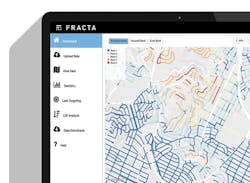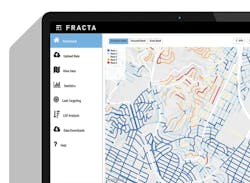Machine Learning in Water Asset Management
By William Steel
Artificial intelligence gains traction in the water market
Murmurings of the emergence of artificial intelligence are unavoidable in today’s modern world. But the technology’s early application in the water sector, a market that is still coming to grips with digitalization of its assets and processes, is prompting optimism.
Broadly speaking, artificial intelligence (AI) refers to computer processes operating in a manner akin to human thought and learning. Machine learning, a major branch of AI, utilizes concepts like pattern recognition and dynamic, real-time data analysis to determine rules that are embedded within and drive data to deliver a powerful modeling and decision-making tool.
Because of its adeptness at handling data, AI makes for an ideal tool in the data-rich world of water asset management. But as Will Maize, a research director at Bluefield Research specializing in municipal water infrastructure projects and trends including smart water technology applications, explained, AI is arriving right on time to accelerate broader changes in the sector.
AI is a highly scalable and economically feasible solution for the large number of water pipes utilities own. Fracta provides its pipe condition assessment software as a service, which begins with constructing data inventories of distribution networks full of asset information.
“Asset management is nothing new — it’s a core function of water utilities. But we’re seeing significant advancements in the traditional processes, with advanced tools and data-driven solutions at the core of it all,” said Maize. “Traditionally, asset management tasks have been isolated within individual utility departments, say operations and financial departments, which can have very different points of view as to how assets are defined and valued.“
Describing how varying incentives and drivers exist within disconnected departments, Maize explained that outcomes, incentives and performance metrics vary considerably across these “siloed” departments, with asset management strategies pulling in different directions and producing outcomes not always geared to best serve the utility, or its customer base, in the most efficient manner.
“A lot of technology adoption has been driven from within utility silos as well,” said Maize. “Consider finance departments. They’re looking at new tools to help automate reporting processes. Or engineering planning, who have brought in hydraulic modeling software or new ways to collect asset data in the field — each are onboarding technology to enhance a unique use case, oftentimes failing to integrate data in a way that can promote multi-departmental use.”
An evolution in asset management, Maize explained, comes with today’s rapidly changing information landscape, establishing an ecosystem in which previously disparate asset data becomes more interconnected. “We’re starting to see geospatial asset management platforms integrate with hydraulic modeling and building information management (BIM) models align with SCADA data-sets on the back end. With larger pools of asset-centric data tagged holistically across department data silos, this is where AI machine learning fits in.”
To date, most applied innovation around AI for the water sector that Bluefield has observed involves the generation of analytical insights leveraging strong data integration capabilities, and as Maize said, “enabling the integration of disparate data sources into a single platform for analysis, visualization, and recommendation — or actuation.”
Beyond data integration, AI is enhancing key decision-making processes, too, providing data-backed recommendations that Maize said will be a “key component for solutions providers to drive engagement with existing utility operators.”
Against this background, solutions providers are developing — and in several instances already offering — AI applications across the full spectrum of municipal water pain-points, from asset investment planning, pipe replacement and risk analysis, event management and predictive leak detection to asset performance monitoring.
AI can assess thousands of miles of pipe in a matter of hours, making it a highly cost-effective solution. Fracta’s datasets feature pipe IDs, pipe measurements and materials and break history, alongside myriad other external variables including GIS data, soil, climate, hydrological, and population data.
“Collecting disparate data flows from performance monitoring of whole networks and assets brings operators critical new insights in terms of relational asset performance and it’s enabling new processes in asset planning and network operations. For instance, enhancing optimal maintenance and replacement programs, and consequently improving how utilities more efficiently allocate capital.”
Bluefield suggests that advanced asset management strategies, which include but extend beyond strictly AI solutions, may save water utilities $41.9 billion in capital expenditures by 2027, with $1.2 billion in annual CAPEX savings in 2018 alone.
Bringing AI to Infrastructure
A prominent player in this new field of solutions is California-based Fracta — an outfit identified by Bluefield as a strategic asset management niche application for condition assessment.
Takashi Kato, co-founder, president and CEO of Fracta, described the water sector as ripe for the application of AI machine learning, an observation he traces back to Fracta’s origins and his earlier experiences in robotic-based oil pipeline inspection. “It was a very costly operation, and the water industry’s profit margin is even lower than oil’s so it really wasn’t practical to apply the same technology for similar problems I saw with water asset condition assessment.”
Kato continued: “We determined AI machine learning-based software for pipe condition assessments was a better direction and moved away from robotics and began with Fracta. AI is a highly scalable and economically feasible solution for the huge scale of water pipe challenges utilities face. AI can assess thousands of miles in a matter of hours, making it a highly cost-effective solution.”
Fracta provides its pipe condition assessment software as a service, which begins with constructing data inventories of distribution networks flush with asset information. Datasets feature pipe IDs, pipe measurements and materials and break history, alongside myriad other external variables including GIS data, soil, climate, hydrological, and population data.
It’s far more data than typically used in condition assessment, or than a human operator could ever process, let alone make sense of — but herein lies the opportunity and power of AI.
Pluto AI’s platform uses deep neural networks to bring data-driven simulations and ROI to the water treatment industry. The company’s approach is to leverage existing SCADA data to enable operators to reduce energy consumption and minimize operating costs.
“Machine learning is excellent for finding meaningful correlations within the data and then deriving a function which can be used for decision making,” Doug Hatler, vice president of sales and marketing for Fracta, said. “In our case, the likelihood of failure (LoF) — a probability score between 0 and 1 that a particular water main will suffer a break within the next five years — is the function we derive.”
Hatler explained that LoF can be utilized with typical risk-based asset management programs incorporating consequence of failure (CoF) analysis to derive a risk score used for asset rehabilitation and replacement planning.
Of course, LoF and CoF concepts aren’t new; but Fracta’s approach represents a highly promising overhaul of convention, one claiming “a faster, more affordable and more accurate method for condition assessment and reaching LoF” in comparison to traditional options such as physical assessment with coupon testing or probes, or conventional computational ‘desktop’ approaches.
There’s inherent human bias and assumptions in those models, something machine learning avoids, said Hatler. “AI is simply more objective. And compared to existing condition assessment methods, it’s very accurate.”
With Fracta’s AI, the real gains in affordability stem from its speed. “Physical and desktop condition assessment can take months or a year of engineering time. We’re able to complete [this] in four to eight weeks depending on quality of input data.”
Viewing their asset data in Fracta with the help of Mapbox, clients are presented with schematics of networks color-coded according to risk ranking, alongside other visual statistics and analytics about their pipe assets and break history.
The data is readily exportable and works with software familiar to water utilities. “Utilities can take the data and couple with CoF work or anything else they’re doing to improve upon rehabilitation and replacement of assets,” noted Hatler.
Besides speed, a key advantage with Fracta is gain in asset return on investment (ROI) by avoiding unnecessary pipe replacements. “It’s about optimization and reallocation of capital to make sure you’re focused on the worst pipes within the context of how your utility is rating CoF against LoF,” said Hatler.
Presently in a self-proclaimed ‘early adopter phase’, Hatler said Fracta is working on building credibility of its methodology through customer engagements. “This year we’re offering 90-day pilot subscriptions for utilities. After the pilot project, we talk single or multi-year contracts.”
Pluto AI has been deployed at multiple water and wastewater plants. The solution allows operators to look at actionable insights derived from plant data and then make more informed decisions.
Several clients are already working on adopting Fracta, having had success with the pilot project.
Describing a recent 5,000+ mile project for a large U.S. city, Hatler said, “Typical engineering approaches on this scale can cost several hundred thousand dollars — and the utility was ready to purchase LoF and CoF software and then hire an engineer full-time for a year. We assessed thousands of miles of pipe in four weeks.”
Fracta identifies markets with multiple drivers of repair and replacement issues and water loss reporting guidelines as ideal candidates for its solution, and so far have undertaken work in Pennsylvania, New Jersey, Texas, and California. Promising negotiations and discussions are taking place in several other states, too.
AI in Plant Operations
AI machine learning is also finding application at the level of individual plant and process management.
As with whole networks, modern plants output large amounts of unstructured data — but it’s very valuable if handled correctly, said Prateek Joshi, founder and president of Pluto AI, a company pioneering such technology.
“AI-based solutions convert this data into wisdom using relevant algorithms, which can then be used to operate the plant more efficiently,” said Joshi.
With a team featuring engineers and data scientists from MIT, Stanford, Nalco Water, Cisco, and others, Joshi said, “We have developed our platform using deep neural networks to bring data-driven simulations and ROI to the water treatment industry. Our approach is to leverage existing SCADA data to enable operators to reduce energy consumption and minimize operating costs.”
Joshi suggests that the solution is valuable because it addresses a fundamental problem in plant operations — reliance on intuition. “Operators have to make multiple decisions every day to control the movement and purification of water within the treatment plant. Due to lack of availability of information, they are forced to rely on guesswork to make these decisions. Our solution enables them to look at actionable insights derived from plant data to then make more informed decisions.”
Pluto AI has been deployed at multiple water and wastewater plants. As an example, Joshi highlighted recent collaboration with a treatment plant in Tennessee to help forecast and predict potential future overflows. “We analyzed its SCADA and sensor data to build a model that forecasts its influent flow based on weather patterns and historical plant data. These results empowered the team to plan pump runtimes and speeds, adjust staffing needs, proactively divert flow to storage, and avoid overflow violations.
The system enabled overflow event prediction with 92 percent accuracy and scenario planning for risk-cost analysis with 96 precent accuracy. Additionally, it averaged a prediction error of only 0.6 MGD for influent flow hourly forecast over the next 7 days.
Overall, it’s estimated that the impacts would produce a 21 precent projected reduction in operating cost over twelve months at the Tennessee plant.
Of course, with data collection being key to AI, it’s important to consider the role of sufficiency sensors and information acquisition technology.
Recalling that Pluto AI is built to work with existing SCADA data, Joshi said, “The industry is at an inflection point. Over the last three to five years, a lot of assets have been fitted with sensors, which lets asset operators collect sufficient data. This enables us to use the historical data to build a model of the asset and deploy our solution to be useful from day one. This helps the operators make informed decisions and take proactive actions.”
Arguably, however, AI solutions will become even more powerful with new, complementary tech. With the prospect of smart pipes with embedded sensors coming to market, Kato noted, “Pipes with embedded sensors are surely part of the future, but we must take baby steps. We cannot replace all our infrastructure overnight! In the meantime, we can accomplish a lot with machine learning.”
Drivers for adoption
While the solutions offered by Pluto AI, Fracta and others may vary in application of machine learning, there are common trends driving the acceleration and adoption of the technology and its innovation in the water sector.
Bluefield identified several macro drivers — including, water scarcity, stricter regulations, and prioritizing of environmental impacts — as motivating uptake of AI solutions that can assist in these areas. Aging infrastructure is another ubiquitous concern encouraging interest.
Pluto AI’s Joshi added: “Energy is the biggest expense of operating a treatment plant. Our customers want to minimize the energy consumption at the plant while maintaining compliance. The only way to do this is to understand how the plant behaves under various conditions and take proactive actions. AI systems enable them to achieve this using the sensor data generated at the plant.”
The quite separate emergence of data as a service is relevant to adoption of AI solutions, too, allowing a shift of upfront costs from CAPEX to OPEX. “That’s reducing barriers to entry for a lot of utilities,” said Maize. “It is especially interesting for smaller to mid-sized utilities with less flexibility in capital deployment and personnel.”
As with all new technologies, Maize observed that some states are ahead of others in terms embracing AI. He noted, too, that “experience with acute water shortages has resulted in certain hot-beds of innovation.” But he emphasized it’s early days for these AI solutions, with “early adopting utilities” under scrutiny from more conservative operators cautious to see evidence of success.
“It’s still early stages for AI — if you look at water-sector-specific AI solution vendors, most saw genesis in the past two or three years. We’re seeing quite a lot of utilities establish pilots, define use cases, and start to stress-test solutions providers.” With some contractual, commercial agreements emerging, Maize said, “We’re at an exciting part of an inflection curve in terms of adoption.”
One challenge to adoption, Maize noted, is that many utilities haven’t deployed data-driven technologies in a way that adds confidence to their existing data. “That’s a problem because analysts (and providers) are saying, ‘Hey, there’s a major opportunity here,’ but when you talk to practitioners, there’s still a lot of uncertainty over this kind of data-science in terms of accuracy and whether it can be relied upon for making decisions.”
Nonetheless, there’s a changing of the guard on the horizon, with clear and present examples of utilities willing to embrace digital tools and seize the power of this new breed of AI technology.
About the Author: William Steel is a freelance reporter based in Denmark. In addition to contributing to various trade journals, he writes about other fields of technology and science at his website, www.phlebas.co.




